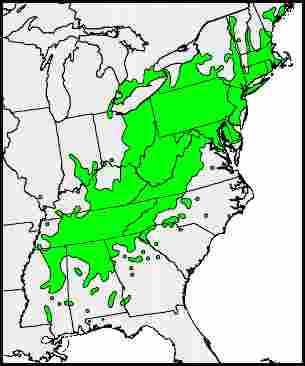American Chestnut
(Castanea dentata)
The American Chestnut was once the most populous tree species in the eastern United States, possibly numbering in excess of four billion individual trees. Many of these were true giants, up to 150 feet tall with trunks more than 12 feet thick. Pioneers often built their cabins from the rot-resistant wood, and the plants were also extremely valuable to wildlife. Unlike most mast-producing trees, which generally only have big crops at two to four year intervals, the Chestnut is a heavy annual bearer. Its nutritious nuts were a primary pre-winter food for many birds and mammals, including turkeys, bears, deer, pigs, and squirrels.
Tragically, in the first half of the twentieth century this magnificent tree was almost completely wiped out by Chestnut Blight (Cryphonectria parasitica). Accidently brought from Asia to New York in the 1890s, the disease needed only a few decades to spread through the tree's entire native range. Only a few rare trees in that range still survive, along with some old stumps that sometimes send up shoots from their roots. Nearly all of the known healthy trees are isolated specimens that had been planted in western states and other areas unaffected by the blight.
But there is a good chance that the American Chestnut can be rescued and even re-established in its old range. By working with genetic material from surviving trees, scientists hope to develop disease-resistant strains. In one approach, the offspring of hybrids with a resistant Asian species are repeatedly crossed with the pure American species, and the Asian tree's characteristics are gradually bred out over a number of generations. It is thought that this process can eventually lead to a 98% pure American form.
There is also interest in the possibility of developing resistant strains from the few trees that still survive in the blight-affected area, but at this point no one knows if that is feasible. Another possible solution to the problem is to insert a disease-resistance gene directly into the American tree's DNA. This could potentially produce an almost 100% pure American form.
It is important to preserve as much of the species' natural diversity as possible, and for this reason scientists want to eventually develop numerous resistant strains. To pave the way for future work in this direction, efforts are being made to collect and preserve genetic material from a large number of surviving trees.
American Chestnut is a vigorous fast-growing tree. It is also adaptable to different soils and climates, and established plants can withstand drought. But because of its size and rather coarse look, and the possible litter of the prickly nut husks, it might be best-suited to a woodlot or semi-wild area. If a large crop of nuts is desired, several trees should be planted to insure good pollination. Trees begin to bear when only a few years old.
At the present time you can safely grow this tree only in areas unaffected by the blight. But you should check carefully before making any purchases. Some of the plants currently being offered are hybrids with other chestnut species.
Other Information
Scientific Name: Castanea dentata
Common Names: Chestnut, American Chestnut
Plant Type: Large deciduous tree
Height: Up to 150 feet
Cultivation Zones: warmer parts of Zone 4 south into Zone 8
Native Habitat: Mostly upland forests
Native Range: The original range ran in a broad irregular swath from upper New England south to Alabama and Mississippi. See distribution map below.
Distribution Map

Range Map Source: U.S. Forest Service. (See General Note C)
Related Species: Allegheny Chinkapin (Castanea pumila) is a small tree native to the Southeast. It produces similar but smaller nuts. The species has some resistance to the blight, but can still be affected.
Plant Sources: Pure (or "almost pure") American Chestnuts with full blight resistance are not available at this time (2005), but hopefully will be in the future. What is presently being sold are "American-like" hybrids containing various admixtures of Asian species. Pure forms with partial resistance are also available. Several selections can be found at Oikos Tree Crops. For a link to this supplier, go to Sources of Plants.
This website contains a report of an old surviving tree found in Kentucky.
The American Chestnut Foundation site has an amazing old photograph of a former giant tree in the Great Smoky Mountains.
|

